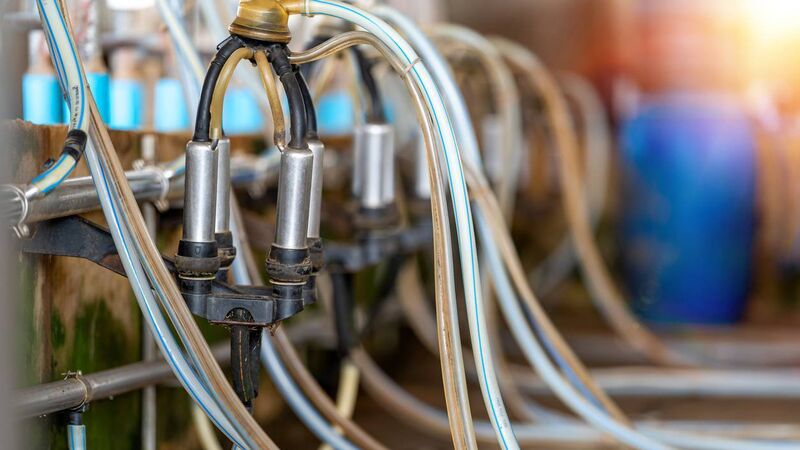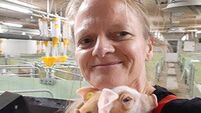Beating the drop this spring: What causes the fall in milk protein?

In certain situations, including when cows are not getting sufficient energy in their diets, milk protein percentages can drop to around 3.2–3.3%.
Milk protein levels generally drop around six weeks post-calving as the milk yield of cows increases.
This rise in milk yield creates a huge energy demand on the cow’s system, and as a result, typically, milk protein percentages will fall between 3.5–3.6%.
However, in certain situations, including when cows are not getting sufficient energy in their diets, milk protein percentages can drop to around 3.2–3.3%.
This drop in milk protein percentages is challenging for herd managers as it can knock the overall milk price received, leading to significant financial losses. So what can farmers do to minimise the fall as much as possible?
There are three key nutritional areas to focus on to avoid a drop in milk protein:
- Dry matter intake;
- Energy demands;
- The starch content of the diet.
Focusing on the cow’s dry matter intake is critical to avoid a drop in milk protein. A lactating cow can eat 3.5% of her body weight in dry matter. In practical terms, this means a 600-kilo cow can eat 21kg of dry matter (DM) daily. This level of dry matter intake is pretty high, but it is very common in herds across the Munster region.
Break down how much feed the cows are getting to determine whether your cows are reaching their dry matter intake potential. A typical cow producing 28 litres of milk will require 6kg of concentrate daily if housed by night and grazing by day. This leaves a dry matter intake requirement of 15kg DM. This gap can be filled by grazed grass or high-quality forage.
If cows are grazing by day and housed by night, they will achieve grass intakes of 7–8kg DM from grass. The remaining 7–8kg of dry matter needs to be filled with high-quality forage. This high-quality forage should be provided as either high-DMD grass silage or, preferably, a total mixed ration (TMR) that contains a high-energy forage, such as maize silage or fodder beet.
Meeting a cow’s dry matter intake requirements is critical, but keeping cows full and making sure they have enough energy are two different things. Energy-dense diets are achieved by offering cows the best ingredients we can source in our diets.
When it comes to concentrates, always look at the feed docket to make sure maize meal and barley are the top two ingredients. Maize meal and barley are high-energy feeds that need to be in the cow’s diet post-calving.
Ideally, in rations for cows in early lactation, focus on using a ration with medium protein percentages (e.g., 16–17%) rather than high-percentage proteins, as the lower the protein, the higher the energy of the feed. High-protein feeds are needed when using grass silage or maize silage, but once grass enters the diet, aim to switch to a lower-protein ration, as the energy levels they provide will always be higher.
Typically, in grazing-based systems, there is usually plenty of crude protein and energy available for cows — but there tends to be a lack of starch.
Starch is a vital component in the cow’s overall diet, as it helps provide a source of digestible carbohydrates to the cow and, as a result, helps improve rumen fermentation. The rumen is a fermenter, and as such, it needs its microbes to be fed high-quality starch sources, like maize silage, rolled barley, ground maize meal and wheat.
The incorporation of high-starch feeds — particularly maize silage — can help prevent a drop in milk protein percentages.
Producers should pay attention when the milk fat percentages drop below 3.6%.
A drop in milk fat is caused by the elevated levels of unsaturated fats or oils that are often present in lush, leafy grass. The combination of high oils and a low NDF in the grass will result in a drop in milk fat. Additionally, low fibre levels can lead to a drop in the rumen pH, which, in turn, can lead to a drop in milk fat.
There are three key areas producers should focus on to prevent a drop in milk fat:
- Rumen health;
- Nutrition;
- Grassland management.
Focusing on maintaining a stable rumen pH of 6.0 will help reduce the risk of milk fat depression. Drops in rumen pH can result in cases of sub-acute ruminal acidosis (SARA). Some signs of SARA to look for in your herd are loose manure passing through the cows quickly and a drop in dry matter intake.
The rumen pH, by nature, will rise and fall in accordance with the cow’s dry matter intake and periods of grazing and rumination. To minimise these drops in rumen pH throughout the day, the rumen needs to be operating in optimal conditions.
A live yeast, such as Yea-Sacc, can help stabilize the rumen pH, as yeasts support fibre digestion through the removal of oxygen and sugar, thereby creating a stable rumen pH, which helps foster an optimal environment for bacteria.
Look at your latest milk test results, and check whether there was a gradual drop in fat or protein over the past 14 days. Any changes to a cow’s diet need to be implemented very slowly to give them time to adjust. If there is a drop in milk fat, look at the composition of the diet and consider what changes could be made.
To avoid a drop in milk fat, it is vital to include a source of digestible fibre in the cow’s diet. When selecting a parlour nut, try to choose one that is high in energy but also offers good levels of fibre.
Avoid feeds that are high in oil content, and focus on feeds that include digestible fibre, such as beet pulp or soya hulls. Offer cows some chopped straw in front of the head barrier before the evening milking to ensure that some form of physical fibre is included in their diets.
If straw is not available, high-quality bale silage can serve as a good-quality roughage in the diet. Fibre is a key nutrient to focus on when cows when grazing lush, leafy covers. By slowing down the rumen's passage rate, you will give the cows a chance to properly ruminate and digest their feed.
As grazed grass makes up 95% of a cow’s diet, it should be a main area of focus in terms of nutrition management over the next few months. At this time of year, grazed grass can include up to 24% crude protein, with dry matters varying between 15–20% depending on the amount of rainfall a region has received.
To avoid a drop in milk solids, consider the following four aspects of grazing:
- Pre-grazing yields;
- Residuals;
- Rotation length;
- Regrowth.
Grass covers of between 1,300–1,500 kg DM/Ha are a must to keep herds from facing a drop in milk solids. At this point, the grass plant should be at the “three-leaf” stage, ensuring that it is fully mature and fit for grazing.
: This term refers to the amount of grass left behind once the cows have finished grazing. Aim for residuals of 100–150 kg DM/Ha, which is the equivalent of grazing between 4-4.5 cm. At this point, the cows will have grazed down low enough to get the fibre from the stem of the plant.
Leaving high residuals (of 300–400 kg DM/Ha, or 5–6 cm) means that the grass will lack quality in the next rotation. While the stem is full of fibre, it lacks the energy that comes from the leaf.
The rotation length, which is determined by the growth rate, needs to be adjusted weekly on the grass wedge. When periods of growth are slower (e.g., at 40 kg DM/day), a rotation length of 23 days will be required. Matching the rotation length with the growth rate helps ensure that the quality is kept in the sward ahead of the cows. See the table below for the advised rotation lengths.
|
Daily growth (kg DM/Ha) |
Target rotation length (days) |
|---|---|
|
40-50 |
22-23 |
|
50-70 |
20-21 |
|
70-80 |
19-20 |
|
80-100 |
17-18 |
Protect the regrowth of the grass plant by avoiding keeping cows in the paddocks for too long. Regrowth tends to be sweet, so cows tend to pick it off when given the chance. Avoid long, narrow paddocks, and aim for paddocks that are square in size, as cows will move through them more evenly.
Determine the correct paddock size for your herd by speaking to your local advisor, as each farm will have different requirements based on their grazing targets.


